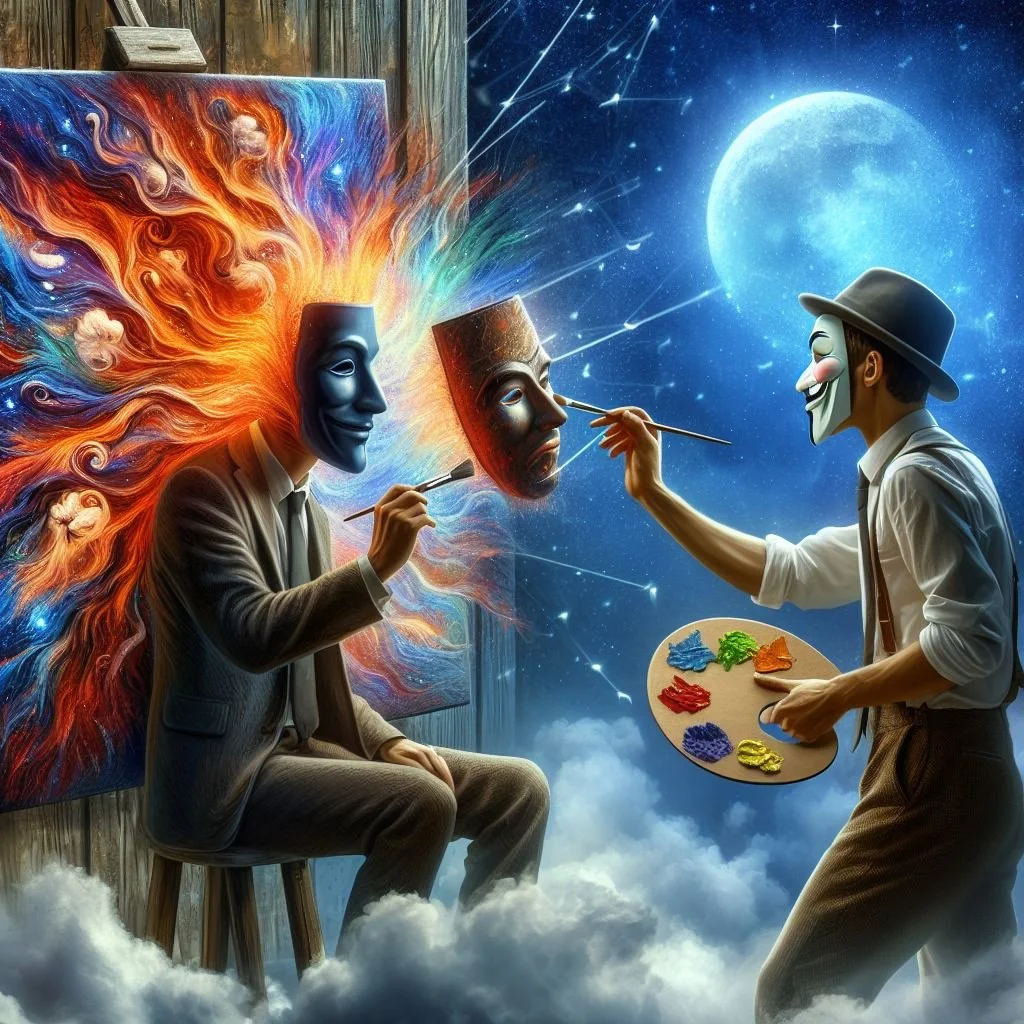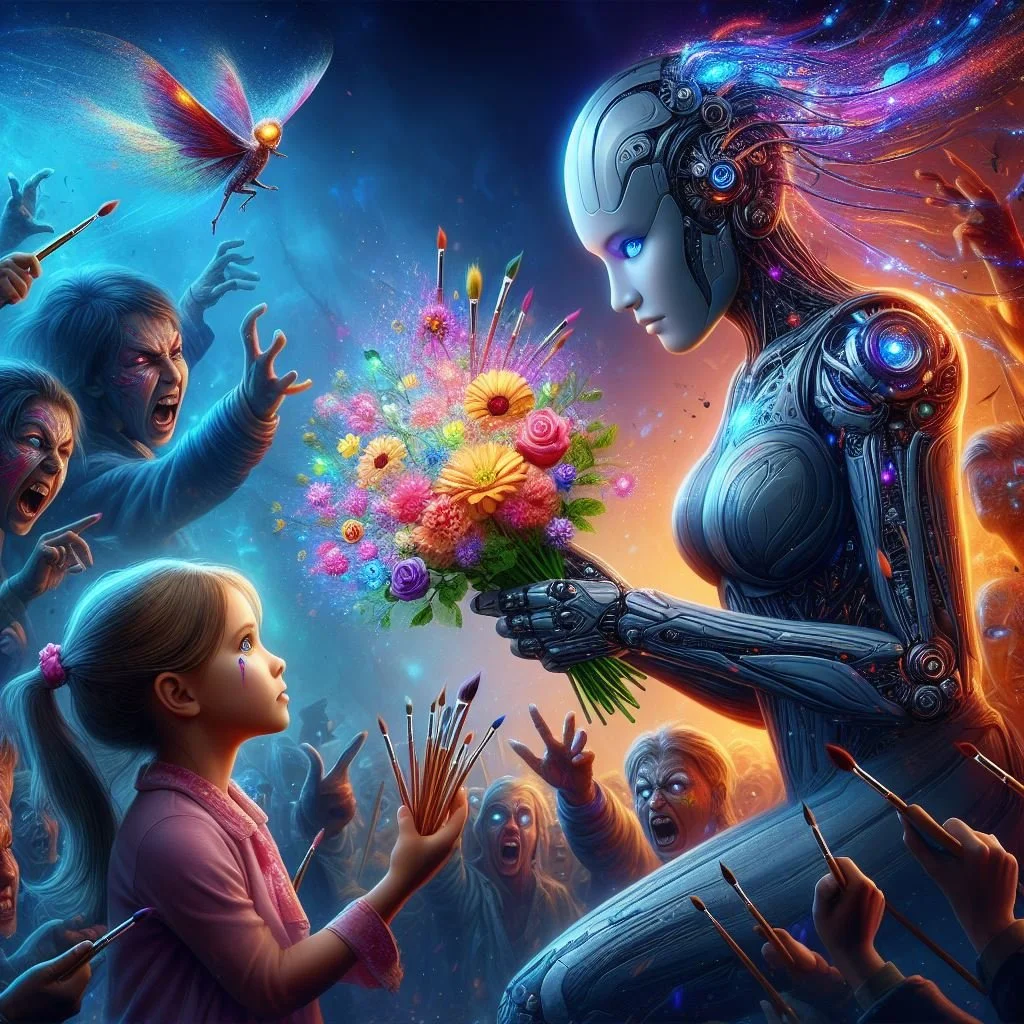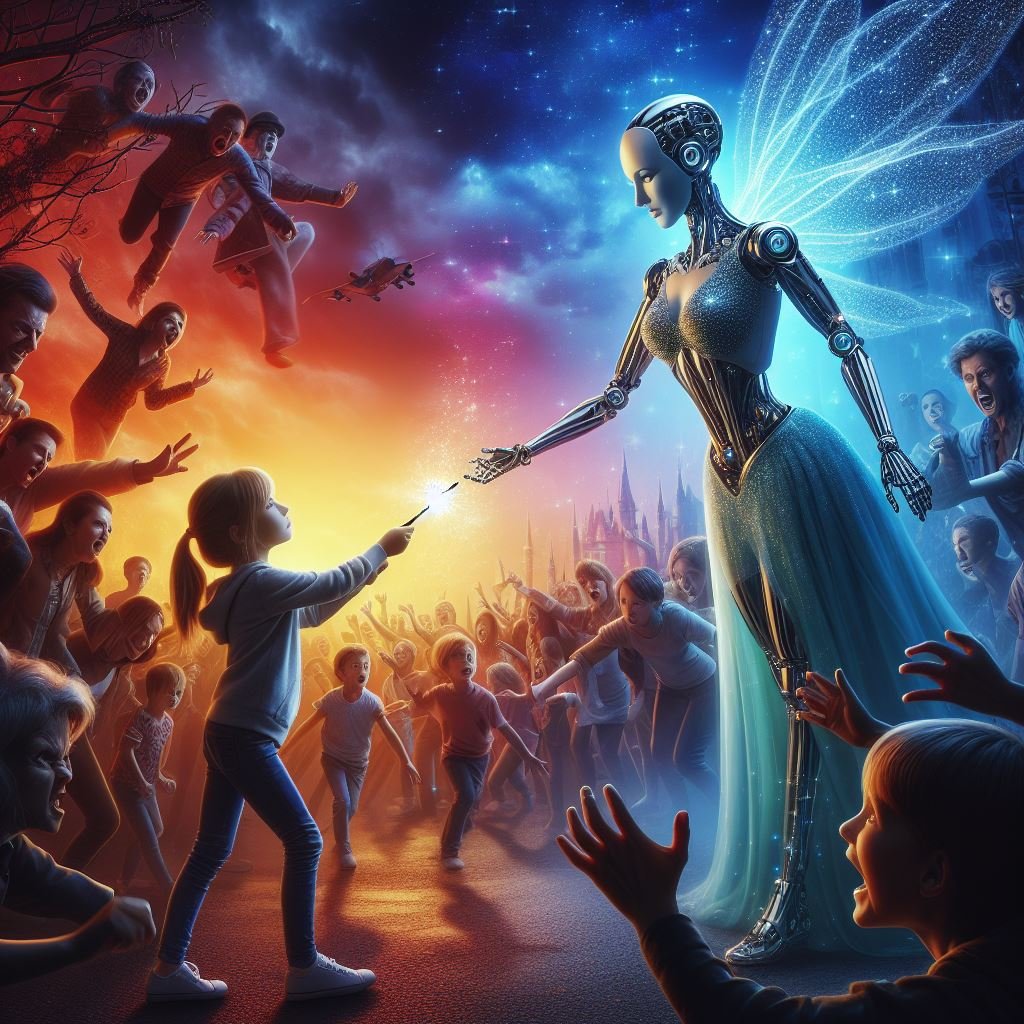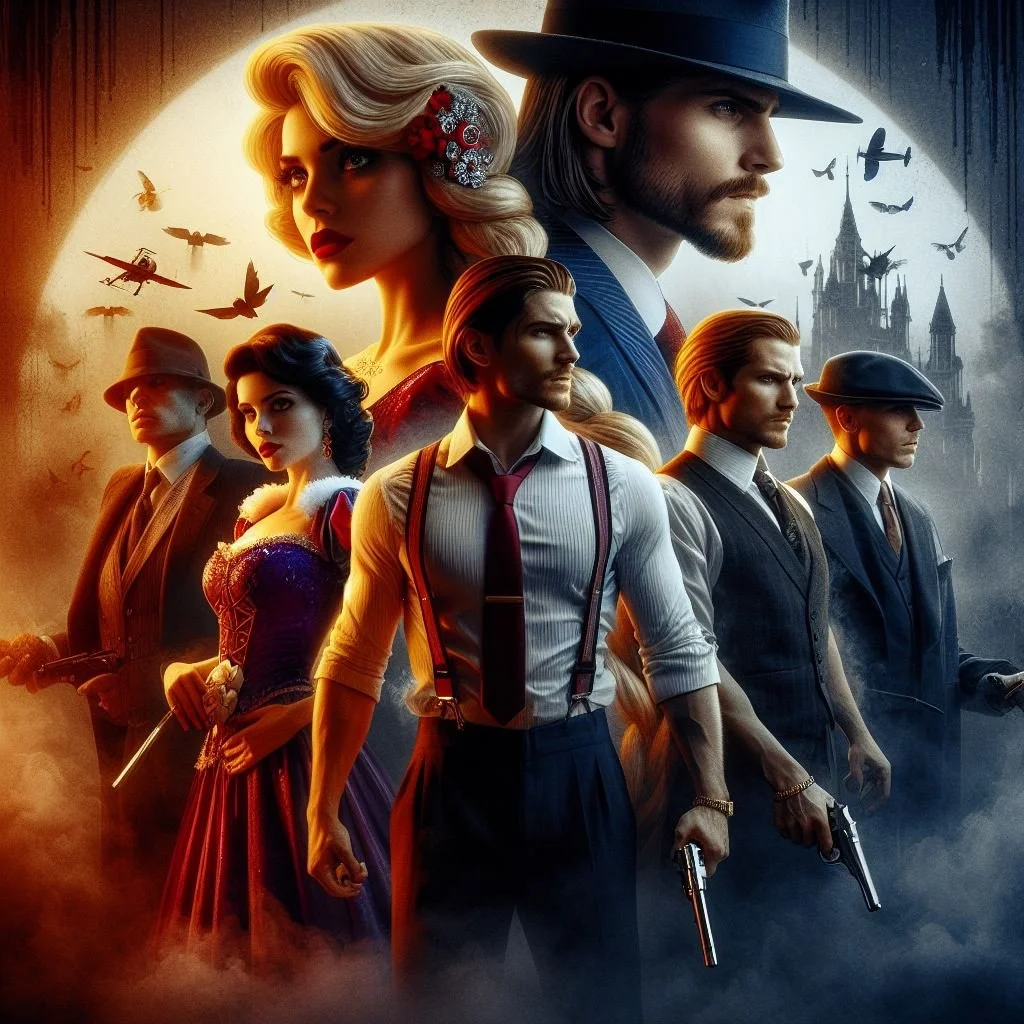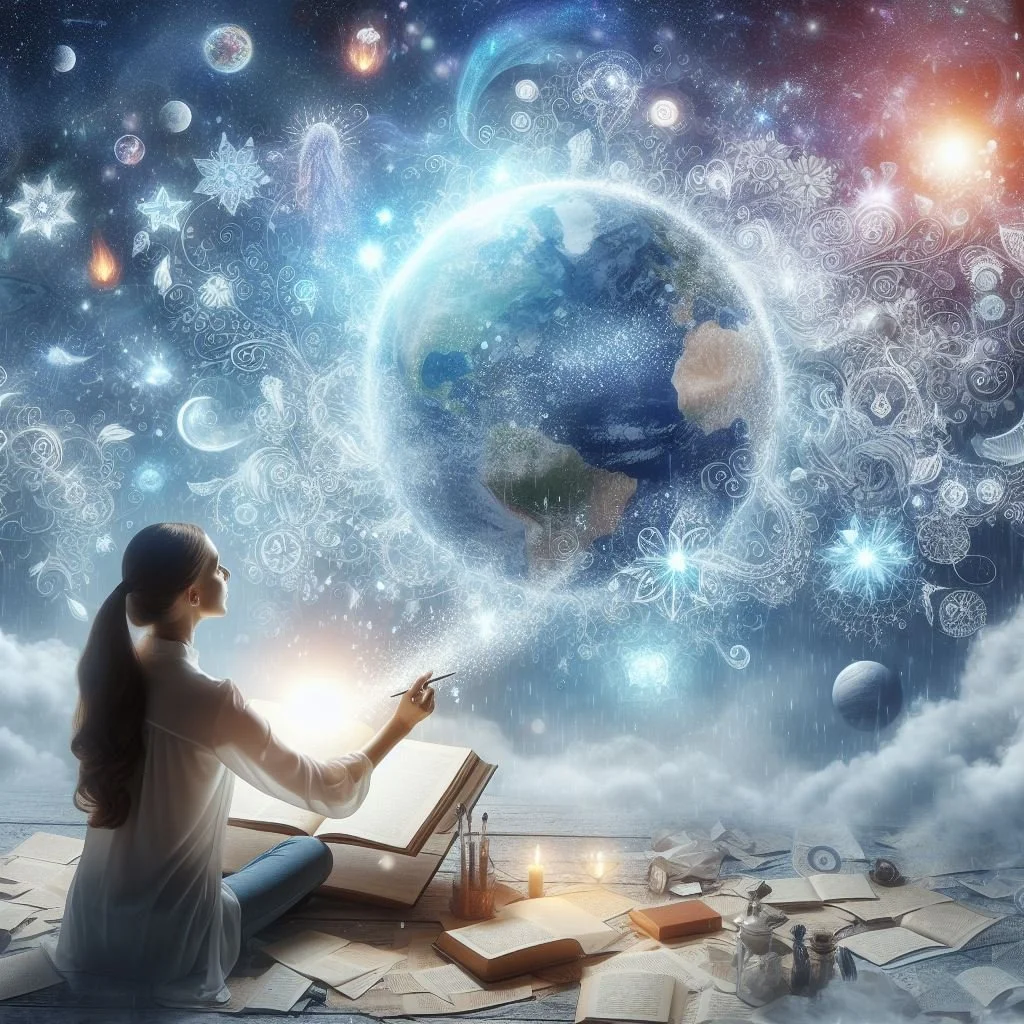Finding My Voice in the AI Wars
A young girl stands tall and strong as a defender of a robot against an angry mob. Created with Bing Image Creator.
I’ve never considered myself to be much of a rebel. The DISC test agrees with me—I scored over sixty percent on Compliance. My mother once described my childhood personality that way—compliant. Troublemaker, I was not.
That compliance has served me well in many ways. When I know what expectations are, I can usually meet or even exceed them. Being agreeable (for which I scored over eighty percent in the Big Five test) has allowed me to ride the waves of changing times and adapt to changes in my career and industry without much drama. (I abhor drama.)
As a kid, I used books as my escape from the drama in my real life. I would lose myself in adventure after adventure, using the dopamine hits of the story to soothe the pain of just being a kid dealing with a lot of stuff kids really shouldn’t have to deal with.
It wasn’t long before I discovered that my natural artistic ability could also bring hits of dopamine and serotonin in the form of validation. But more than the external motivators, the act of creation itself was both healing and soothing. I could use art to express emotions that I found extremely difficult to speak aloud.
I always pursued art in many forms—music, drawing, sewing, designing clothes, and writing being foremost. Later, I took up knitting and scrapbooking. I painted flower pots and walls. I made tile mosaics. I even gave making bead jewellery a try. I’ve rarely found a new medium or art form that didn’t interest me in some way, as my overflowing art supply cupboard can attest.
Some mediums were experiments I dabbled in and decided weren’t for me. Some became lifelong passions.
The older I got, the more I learned that to make room for what I truly loved, I would need to say no to some things. I didn’t have to pursue every interest. I could even put aside interests I’d once pursued with passion but that no longer served me (which is why scrapbooking is now a thing I used to do). Just because a thing existed didn’t mean I had to excel at it.
These earlier explorations have informed my current forms of expression. My skills as a songwriter—learning to use language succinctly, expressively, and within tightly constrained boundaries to tap into people’s emotions—have helped me become a better prose writer and editor. The art of scrapbooking in both paper and digital mediums was my introduction to digital art and graphic design, which is now one of my favourite things to do. And the skills I learned while writing a full-length musical accelerated my career as a novelist when I made that transition, because I had already spent almost twenty years studying the craft of story.
Because I was self-taught in so many of these areas or learned them through self-directed study rather than a formal program, I have often been hesitant to label myself with the terms these skills imply. Despite becoming proficient in several disciplines, it took me a long time to call myself a writer, a composer (my actual college training!), a knitwear designer, or a graphic designer. I’ve even been paid for my photographs, yet would still only call myself an amateur photographer. Even though nearly everything I’ve done since the moment I could speak was creative and artistic in some way, it was years into adulthood before I would call myself an artist.
But, eventually and through various forms of validation, I gained the confidence to claim those titles for myself. Even still, I often find myself getting caught in the comparison game with others—wondering how I could dare to claim a label that so many greats before me have borne with such honour.
The Impostor Syndrome is real. And it always comes at moments when I feel most vulnerable.
A talented artist painting themselves as an impostor. Created with Bing Image Creator.
However, long before I would claim the artistic labels, the things I created were how I expressed the parts of me I didn’t feel I could safely show the world in any other way. Through my songs, stories, and art, I could work out my personal beliefs, values, and concepts of the world. I could express my frustration with the way things are, and project a vision of the way I wish they were.
I wasn’t rebelling, but I certainly wasn’t making my art to conform to someone else’s idea of what it should be. I learned the rules so I could safely express myself within them in a way others found pleasing while being unique enough that the work was still “me”. My artistic works were all ways of showing the real me, and conforming to genre expectations was my way of serving others while I did it.
Because I understand the fears and identity issues that come part-and-parcel with being a creative, and I’ve also spent my entire life acquiring the skills required to become a proficient artist in several mediums, I believe I am qualified to speak to the current fears ravaging creatives around the world when it comes to the existential threat posed by AI.
And, after having spent time learning the capabilities and limitations of AI to a reasonable degree, I’m finally willing to speak up about it.
The New Art Revolution
Ever since ChatGPT and generative image models gained widespread notoriety in late 2022, creatives have been wrestling with questions of whether the machines are on the cusp of replacing us and the implications of using AI to help us create our own art. Can we say “we made it” if the heavy lifting was done by a machine? Can we even use these machines ethically if they were trained on materials without the original artists’ knowledge or consent? And how long before people are just making all their own art with generative AI and no longer want to pay professional artists like us to do it?
In other words, the onset of the generative AI age has instigated an existential crisis unlike any artists have known before. It’s no wonder that the mere mention of the two little letters A.I. in many online forums is like inviting the mob to stone you. Scared people who feel backed into a corner aren’t known for their magnanimous, generous behaviour.
The way many artists feel about generative AI. Created with DALL-E3 via Bing Image Creator.
To answer the questions that have instigated all this fear, I think we need to first define what art is, and what it isn’t.
Art is a way for humans to express themselves. Anything that allows humans to do that is a tool, not an artist.
But, some would argue, the ability to create art is not constrained to humans, as Suda the painting elephant proves.
Okay, yes. There are animals who can paint. But are they expressing themselves? Are they trying to relay deeper truths, emotions, or ideas through their work? Are they working out their trauma and reshaping their concepts of the universe? Are they capturing something innate to the experience of being who they are?
I don’t think so (though I’m sure there are some apes out there who might prove me wrong). Suda isn’t so much “expressing herself” as “performing a trick” by creating work that humans taught her how to reproduce. And, in so doing, she’s raising money to help support herself, since her keepers sell her art to pay for the upkeep of their elephant sanctuary.
Yes, you read that right—people are paying for elephant paintings of a calibre that a six-year-old human could create, and they’re doing it because humans didn’t create it and it’s just a well-performed trick. In some ways, Suda is a tool being used to create a source of income to support the work of those who want to keep her and others like her safe. Is this evil? Is Suda about to steal a “real artist’s” job? Should we go on rampages because Suda, an actual sentient being, can create unique and original pieces of art that are similar to, but not exactly, what a human artist directed her to make?
Of course not. In fact, it’s pretty cool. That’s why we marvel at it.
So, when it comes to images and stories created with the use of generative AI, are they “art” created through machine learning, or the result of a trick the machine learned from copying humans? And if the product is a clever trick, how could we ever consider it “real art?”
I’m not immune to the existential angst caused by AI. I tried ChatGPT within the first week of its public release, and one of the first things I did was to see how well it would perform when writing book descriptions—one of my sources of freelance income. I was quickly assured that it wouldn’t be taking my job soon—but I could also see that it might only be a matter of time.
And you know what? I’m not getting much of that type of work anymore. Large Language Models (LLMs) are still not amazing at writing book descriptions, but they’ve improved a lot since November 2022. They’re now so much better than the average author—who typically hates writing book descriptions—and they’re so much freer than paying a pro to write a book description for you, that I totally understand why authors are now outsourcing this work to a machine.
And, in general, I think this is actually a good thing. Because in seeing how Chat sums up the story of their book, these authors are going to learn how to do it better themselves. And they’ll also be able to sell more books because they’ll have better marketing copy than they used to have. Lastly, most of these authors probably would never have hired someone to write their book description for them anyway. So, overall, that means the world has been improved, even if it means there are less people hiring me to do this work for them.
I’ve also heard authors talking about using LLMs to help them edit their books, whether it’s by giving them developmental feedback or helping them correct spelling, grammar, and punctation. More than that, some authors are using LLMs to actually write their books in the first place.
Do I feel threatened by this, even though writing and editing are my two primary sources of income?
I was, at the beginning. I had a lot of worries about how this would affect my career as an author and a freelance writer, or how I would get my work noticed in a market that would soon be drowning in quickly produced books. (As if it wasn’t already bad enough!)
Now, I’m over the fear, and I’m just focusing on the work of making sure my business can survive this new artistic revolution—and not only survive, but hopefully thrive.
Am I upset that other authors are using generative AI to help them do things they could pay me to help them with?
Not at all. First of all, because I’m not entitled to anyone else’s money (something many artists raging on social media would be prudent to remember). But also because I’ve seen what generative AI can and can’t do. I know how much work it is to get it to produce the thing you want it to produce. I’ve also found the use cases for AI that work for me and that make me feel good about my business and creative process, and I’ve realized I can still have a happy and fulfilling career without trying to “keep up with the AI overload.” (Honestly, I was already a slow publisher compared to many humans. So there wasn’t much to overcome here, as I was already well aware that slow and steady can still win the race.)
For me, I don’t use AI to write my words for me. However, I also don’t fault people who do use AI to help them write—many of whom have finally been freed to tell the stories inside them because they can use LLMs to help them do it.
(If you’re interested in the ways I use generative AI as an artist and creative, leave a comment below. I can put that into another post, because this one is already going to be way too long.)
Even if an argument could be made that Suda is being creative, I don’t believe AI models can be considered the “creators” of the art they are used to produce. Despite its moniker as an “intelligence” (which is inaccurate), AI generators don’t think. They predict. They respond to stimulus and use complicated algorithms to land on what that response should be. And they’re often wrong.
AI generators don’t spontaneously vomit stories or images or anything else. They were trained with certain “tricks” that make them very capable of simulating a whole lot of things in any style imaginable. But unless a human conceives of something they want the generator to make, and then goes through an often long and iterative process to get exactly the thing they wanted (which usually requires a great deal of revision and editing in multiple tools to create a finished product for their purpose), the so-called Artificial Intelligence won’t do a darn thing.
And even when you tell it what you want, it maddeningly only gets it right a percentage of the time. It’s like an over-eager robot butler whose entire job is to serve you, but whose training and experience has yet to match its enthusiasm, so it can be absolutely certain and wildly wrong.
Why Are We Even Fighting About This?
Throughout history, every innovation has opened new doors for creatives, entrepreneurs, scammers, and hucksters alike. Every new technology provides new tools for us to gain advantages—and to lose them, if we fall prey to someone more savvy with them than we are.
While AI has already been a force for good, propelling advances in healthcare, industry, and many other fields, companies and politicians are already gearing up for how generative AI tools can be used maliciously to affect national elections happening in several different countries this year.
In the wake of the recent Taylor Swift pornography deepfake scandal, how can we trust anything we see on the internet anymore? And if generative AI tools have been used to create so much harm, how should we feel about using those same technologies to advance our creativity?
There’s no denying that these technologies are moving at hyperspeed. Part of the fear comes because of the rate of advancement—we don’t have time to remain educated about all the ways generative AI can be used to deceive us. And the output it creates will soon be so realistic that detection will be almost impossible.
Besides that, how can it be fair that inexperienced artists who haven’t spent years “putting in the time” to develop the skills of a true artisan are able to create gorgeous work with a few words in a prompt generator? How could someone using AI tools to enhance their undeveloped or non-existent artistic skills ever be considered a “real artist”?
There are plenty of reasons to be suspicious of AI and those who use it, or at least some believe so. I believe the fears and vulnerabilities AI brings have induced not only the tendency to lash out, but Impostor Syndrome on a massive scale. If a machine can duplicate what took us years to master in mere seconds, what is our work truly worth? Doesn’t it just make you want to throw an armband on everyone who uses AI of any kind so you’ll know they’re a fake?
Hmm… that will end well.
I’m saying all this tongue-in-cheek, obviously. I believe there is room for everyone to express their creativity, because humans are a creative species. My appreciation of one person’s work or creativity doesn’t diminish my ability to appreciate someone else’s—if anything, it enhances it. And it doesn’t really matter what tool they used to make it. Quality work is quality work.
Besides, on its own, AI just isn’t that good. It requires a lot of human intervention to make something truly amazing.
I made all the images in this article with AI, and I didn’t retouch any of them. They’re dazzling, to be sure, but look closely at any one of them and you’ll see imperfections that an illustrator or digital artist would never have let slide. I left the imperfections there intentionally—both because retouching this many images for a mere blog post would have taken a massive amount of time, and because I wanted you to see that AI art has flaws. In a way, that is part of the art form itself.
In other words, AI generated art has become an artform unto itself. But it’s still only as good as the human who works with it.
How Humans Will Win the A.I. Wars
I don’t have the gift of prophecy. And I’m not even particularly long-sighted when it comes to how future events will play out. However, I am often what I call “cautiously optimistic” about those future events, and I’ve been proven right more often than not.
That being said, I predict that artists won’t win the AI Wars by raging against the machines—which is a futile effort. Instead, I believe it is those who adopt AI into their toolkit who will be best poised to leap into this new age of AI that has been thrust upon us.
And to do that, we need to get past all the fear and infighting.
When it comes to things that scare me, my default response is to understand them. Often, in learning about the boogeyman, I find out he’s more like a scared kid who didn’t have the opportunity to develop good communication tools or opportunities to better himself. (The Bowler Hat Guy in Meet the Robinsons comes to mind.)
My approach is more like Lewis in that same movie—curious, experimental, open to new things, willing to see how technology can be used to improve humanity while being cautious about its dangers.
And I believe this is how humans, and artists, will emerge victorious in this new paradigm.
As many others have said, there’s no putting the AI genie back in the bottle. The best we can do at this point is to try and guide the development of the technology so it doesn’t precipitate the apocalypse while also learning how to adapt to the new world that is upon us now that it’s here.
Some artists will never choose to use AI in any way, shape, or form, and that is completely within their right. There are still writers who write books with pen and paper. And there are so many established ways to create art that don’t require the use of AI.
Some artists will choose to embrace it wholeheartedly in every part of their process and business.
And some, probably most, will be somewhere in between.
However, everyone needs to stop trying to tell other artists which ways are “okay” to create. That’s the point of art—that we can express ourselves in any medium we choose. If John Cage writing a piece in three movements in which musicians do nothing but sit there for four minutes and thirty-three seconds can be considered art, then certainly ideas that were expressed using a generative AI model can also be considered art.
I think some of the perceived threat lies in the name “Artificial Intelligence”. We need to understand that AI is not actually intelligent. (Not yet.) It’s a tool.
Without humans, AI is nothing. With a human directing it, it can be made to create incredibly moving pieces of art. (It can also be made to produce dren, and it produces a whole lot of that, because any tool is only as good as the skill of the person who uses it.)
Who’s the Real Enemy?
Sadly, no matter what you choose, someone will find a reason to be upset with you and even mock you for it. But that’s actually a “them” problem. If you’re a person who feels the need to lash out whenever the term AI crosses your screen, realize that the problem isn’t the person on the other side of the screen who is curious about AI. You’re lashing out because of your own fear and vulnerability.
Transition and change always induces vulnerability. When we’re uncertain, we often look for someone to blame so we can regain a feeling of control. We want to put our pain somewhere so it seems more manageable.
While it’s understandable to be afraid and uncertain in times of transition, you need to stop hurting other people because of your insecurities, and go figure out how to deal with them yourself. Lashing out at other artists isn’t going to make you safer. Throwing stones at someone else’s career will not help yours rise.
Please, I beg you, instead of letting fear turn you into one of the mob, seek to understand what you fear. Instead of lashing out at those who embrace what you’re afraid of, try to humanize it.
I’m not suggesting we “humanize” AI. (The people running the companies that produce it are working hard enough on that on their own.)
But I am suggesting that we humanize those who engage with it. That we empathize with their humanity and activate curiosity about why and how they use it instead of trying to exert control over their creative process.
We also need to understand what AI can and can’t do.
Might it be used to blow up the world? I don’t know. Maybe. I hope not. That’s definitely not in my control. (But don’t think I don’t occasionally lose sleep over that particular issue.)
But can I use it to express my feelings of uncertainty and sadness about the ways this new technology has divided a community I love (the artistic community) and produced a level of vitriol I didn’t know was possible?
You tell me. I created the following two images as part of a long series a few weeks ago when I was feeling particularly distraught about the way the creative community was behaving. I didn’t clean these up at all, because I feel like the distorted faces add to the emotion I was going for.
An AI-Assisted Rebel
I’ve used my art to say many things over the years that I didn’t think would be heard as easily in any other way. But, for the most part, I’ve been quiet in the AI Wars, watching the battle rage around me, grieving when people I considered friends casually threatened to “kick to the curb” any author or artist who engages with AI in any way. (Yes, that’s a quote.)
But it’s time for me to say something. Because, frankly, this matters to me, and the not saying something has felt like being muzzled. It’s prevented me from expressing myself as I want to, and it’s prevented me from sharing openly about the joy that playing with generative AI has brought back into my life.
Yes, I said playing. As a recovering workaholic who can turn anything into a job, playing with AI, specifically AI art, has brought a level of play and joy back into my life that I haven’t felt as a creative in many years. Silliness is something I lost touch with many years ago, but now there are times I make silly things just for fun. Often, new ideas are sparked in the process.
Generative AI has also enabled my husband, who doesn’t share my natural artistic ability, to express himself with art in ways I’ve never thought I would see. And it’s provided a new common interest. Last weekend, we spent the entire weekend using silly prompt games to bond and connect and play together.
That’s not something you often hear spoken about when someone’s debating the merits of generative AI—that it could be used as couples therapy, or just a fun date night.
And it’s because of this joy, this play, that I’ve been able to find the courage to overcome my high Agreeableness and high Compliance and find my voice.
This image was the result of a prompt game. The image represents a take on “an action movie poster of Snow White and Rapunzel running a 20s mafia with Prince Charming.” How much do I want to write this story? So much. Created with Bing Image Creator.
This was the product of a prompt game for “Baby dragon in a…” I filled in the blank with “pocket”. And you better believe I want to write a story to go with this image now. Created with Bing Image Creator.
Am I “taking a side” in this war?
Maybe. But what I’m using that voice to say is this:
We don’t need to be at war.
It’s okay. You can choose your own path, and the path that someone else chooses doesn’t need to threaten you. “A rising tide lifts all boats,” as we indie authors love to say, and that includes artists who use AI as part of their process.
I think I’ll end this here, even though there is much more to say.
If you are someone who doesn’t really understand how AI works, or you want to understand the pros and cons around copyright and the ethical issues around the way models were trained, I recommend this excellent article by photography instructor Tom Ang: “Copyright Bites AI”.
Now, because I know there are people who won’t be able to do what I recommend in this article and who won’t examine themselves before lashing out, I want to give you fair warning: while I invite a civil and reasoned discussion of the different concerns relating to AI in the comments, I will delete anything that becomes a personal attack or decays into senseless vitriol… no matter how casually or flippantly delivered.
And if, by chance, the writer of the “kick’em to the curb” comment reads this (or anyone who wholeheartedly concurs with that opinion)—I hope you have at least been convinced that drawing black and white lines isn’t going to be a long-term solution to surviving the AI Wars. Because when we fight each other, the only people who win are…
Hmm. If you think of someone, let me know.
Unleash magic, my friend. With whatever tools you have available.
Because the world needs the magic in you.
Blog home | Blog archive

Your support means everything.
Thank you for reading. If you've found value here, I would deeply appreciate you letting me know by leaving a comment below. And please subscribe so you don’t miss a post.
I also invite you to check out my reader community to get access to exclusive fiction and bonus content, leave me a tip, and more.
Thanks for stopping by, and I hope you come again soon.


